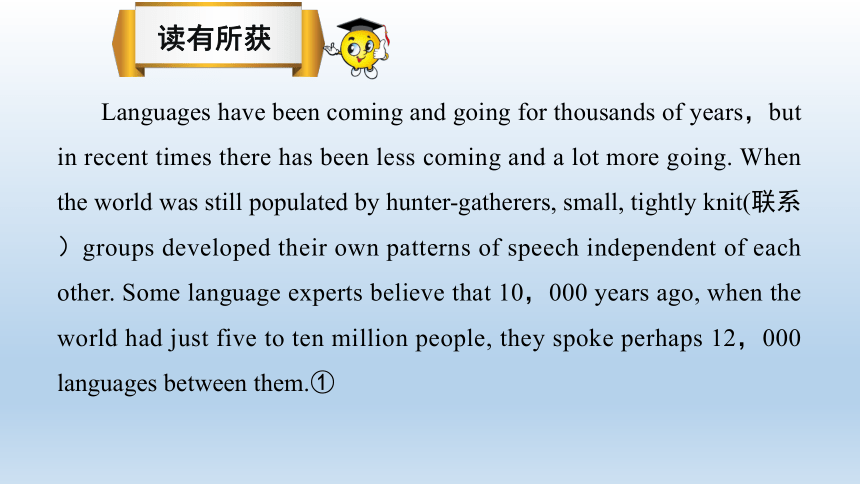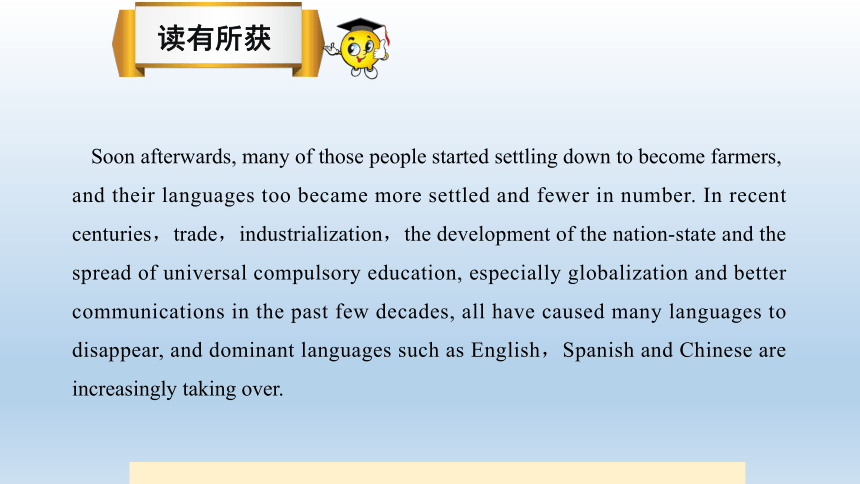人教版(2019)高中英语必修第一册 Unit5 Languages around the world单元高考阅读课件(共12张PPT)
文档属性
| 名称 | 人教版(2019)高中英语必修第一册 Unit5 Languages around the world单元高考阅读课件(共12张PPT) |  | |
| 格式 | ppt | ||
| 文件大小 | 3.8MB | ||
| 资源类型 | 教案 | ||
| 版本资源 | 人教版(2019) | ||
| 科目 | 英语 | ||
| 更新时间 | 2023-03-09 15:17:11 | ||
图片预览






文档简介
(共12张PPT)
素养阅读系列
单元高考阅读
读有所获
练有所得
词汇积累
长难句分析
学有所益
读有所获
阅读提示:语言已有几千年的历史,本文从语言发展历史这一角度论述了人类的发展导致了世界上语言数量的减少。
读有所获
Languages have been coming and going for thousands of years,but in recent times there has been less coming and a lot more going. When the world was still populated by hunter-gatherers, small, tightly knit(联系)groups developed their own patterns of speech independent of each other. Some language experts believe that 10,000 years ago, when the world had just five to ten million people, they spoke perhaps 12,000 languages between them.①
读有所获
Soon afterwards, many of those people started settling down to become farmers, and their languages too became more settled and fewer in number. In recent centuries,trade,industrialization,the development of the nation-state and the spread of universal compulsory education, especially globalization and better communications in the past few decades, all have caused many languages to disappear, and dominant languages such as English,Spanish and Chinese are increasingly taking over.
读有所获
At present, the world has about 6,800 languages. The distribution of these languages is hugely uneven. The general rule is that mild zones have relatively few languages, often spoken by many people, while hot, wet zones have lots, often spoken by small numbers. Europe has only around 200 languages ; the Americas about 1,000 ; Africa 2,400 ; and Asia and the Pacific perhaps 3,200,of which Papua New Guinea alone accounts for well over 800. The median number (中位数)of speakers is a mere 6,000, which means that half the world’s languages are spoken by fewer people than that.②
读有所获
Already well over 400 of the total of 6,800 languages are close to extinction(消亡),with only a few elderly speakers left. Pick, at random, Busuu in Cameroon ( eight remaining speakers ),Chiapaneco in Mexico (150),Li pan Apache in the United States (two or three) or Wadjigu in Australia (one,with a question-mark):none of these seems to have much chance of survival.
答案:1.B.
答
案
解
析
1
练有所得
What can we infer about languages in hunter-gatherer times
A. They developed very fast.
B. They were large in number.
C. They had similar patterns.
D. They were closely connected.
答案:2.B.
答
案
解
析
2
练有所得
How many languages are spoken by less than 6,000 people at present
A. About 6,800.
B. About 3,400.
C. About 2,400.
D. About 1,200.
1. populate 居住于
2. industrialization 工业化
3. globalization n.全球化
4. distribution n.分布
5. at random 随意地,随机地
考纲词汇
学有所益
长难句分析
①句意:一些语言专家认为,10,000年前,当时世界上只有五百万至一千万人口,他们之间可能要说12,000种语言。分析:本句是一个主从复合句,在that引导的宾语从句中,包含一个when引导的非限制性定语从句。
②句意:不同语言使用人数的中位数仅是6,000这意味着世界上有一半的语言的使用人数不到6,000。分析:本句是一个包含非限制性定语从句的主从复合句,which代指逗号前的整个主句。
“数据性细节理解题”的解题技巧:数据性细节理解题所涉及的信息通常是时间的长短,年龄的大小,数量或价格的多少等。解题方法:解此类题的关键常常不在于数据与计算本身而在于弄清数据之间或数据与文中其他信息之间的逻辑关系。不管问题以何种形式出现,只要题干问的是数字,就从文章中的数字下手。读文章时最好能圈出有关数据,以免做题时再浪费时间查找。根据原文中的数据进行推理运算,最终确定答案。
学有所益
方法归纳
素养阅读系列
单元高考阅读
读有所获
练有所得
词汇积累
长难句分析
学有所益
读有所获
阅读提示:语言已有几千年的历史,本文从语言发展历史这一角度论述了人类的发展导致了世界上语言数量的减少。
读有所获
Languages have been coming and going for thousands of years,but in recent times there has been less coming and a lot more going. When the world was still populated by hunter-gatherers, small, tightly knit(联系)groups developed their own patterns of speech independent of each other. Some language experts believe that 10,000 years ago, when the world had just five to ten million people, they spoke perhaps 12,000 languages between them.①
读有所获
Soon afterwards, many of those people started settling down to become farmers, and their languages too became more settled and fewer in number. In recent centuries,trade,industrialization,the development of the nation-state and the spread of universal compulsory education, especially globalization and better communications in the past few decades, all have caused many languages to disappear, and dominant languages such as English,Spanish and Chinese are increasingly taking over.
读有所获
At present, the world has about 6,800 languages. The distribution of these languages is hugely uneven. The general rule is that mild zones have relatively few languages, often spoken by many people, while hot, wet zones have lots, often spoken by small numbers. Europe has only around 200 languages ; the Americas about 1,000 ; Africa 2,400 ; and Asia and the Pacific perhaps 3,200,of which Papua New Guinea alone accounts for well over 800. The median number (中位数)of speakers is a mere 6,000, which means that half the world’s languages are spoken by fewer people than that.②
读有所获
Already well over 400 of the total of 6,800 languages are close to extinction(消亡),with only a few elderly speakers left. Pick, at random, Busuu in Cameroon ( eight remaining speakers ),Chiapaneco in Mexico (150),Li pan Apache in the United States (two or three) or Wadjigu in Australia (one,with a question-mark):none of these seems to have much chance of survival.
答案:1.B.
答
案
解
析
1
练有所得
What can we infer about languages in hunter-gatherer times
A. They developed very fast.
B. They were large in number.
C. They had similar patterns.
D. They were closely connected.
答案:2.B.
答
案
解
析
2
练有所得
How many languages are spoken by less than 6,000 people at present
A. About 6,800.
B. About 3,400.
C. About 2,400.
D. About 1,200.
1. populate 居住于
2. industrialization 工业化
3. globalization n.全球化
4. distribution n.分布
5. at random 随意地,随机地
考纲词汇
学有所益
长难句分析
①句意:一些语言专家认为,10,000年前,当时世界上只有五百万至一千万人口,他们之间可能要说12,000种语言。分析:本句是一个主从复合句,在that引导的宾语从句中,包含一个when引导的非限制性定语从句。
②句意:不同语言使用人数的中位数仅是6,000这意味着世界上有一半的语言的使用人数不到6,000。分析:本句是一个包含非限制性定语从句的主从复合句,which代指逗号前的整个主句。
“数据性细节理解题”的解题技巧:数据性细节理解题所涉及的信息通常是时间的长短,年龄的大小,数量或价格的多少等。解题方法:解此类题的关键常常不在于数据与计算本身而在于弄清数据之间或数据与文中其他信息之间的逻辑关系。不管问题以何种形式出现,只要题干问的是数字,就从文章中的数字下手。读文章时最好能圈出有关数据,以免做题时再浪费时间查找。根据原文中的数据进行推理运算,最终确定答案。
学有所益
方法归纳
